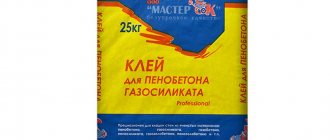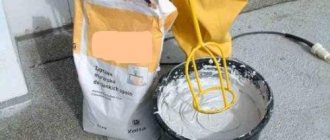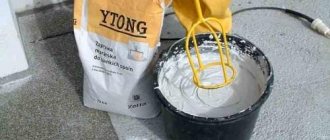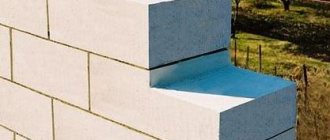Foam concrete is becoming an increasingly popular material for building houses. It retains heat well and can serve for many years, but getting the maximum from these characteristics is only possible if the installation is done with glue for foam blocks; the use of cement mortar is not so effective. In this case, you need to choose a suitable solution. The existing types and rules of work will be discussed in more detail below.
Cement base or glue
For masonry, you can use both glue and classic cement composition. A realistic assessment of the construction process will help you make a choice. If foam concrete modules are non-standard in size or have an unusual shape, preference should be given to a cement-based solution.
It is better to use professional glue in the following situations:
- Sufficient experience and skill level of the construction team.
- Foam concrete blocks having strictly regulated sizes and shapes.
The special glue is free of impurities and various additives that can cause sediment to appear. The only permissible component (mandatory for use) is fine sand, and to improve the degree of adhesion, polymers and plasticizers are introduced into the solution.
Composition and characteristics
The composition of any adhesive solution for blocks includes the following components: cement, special glue, additives, high quality fillers that improve characteristics. It is sold in a dry standard 25 kg bag. It also contains additives and moisture-retaining components to protect against excess moisture and mold formation. Special additives make the seams plastic, which eliminates the deformation of the masonry due to sudden temperature changes. To protect against frost, additives are added to the adhesive mixture, which allows construction work to be carried out in winter.
Return to contents
Advantages of adhesive for foam blocks
Carrying out repair and construction work with your own hands requires a detailed approach to the choice of consumables. This rule applies to both main blocks, modules, slats, and fixing compounds.
The quality of the fixative used will determine the duration of operation of the building, tightness, and heat retention in the room.
The positive characteristics of adhesive for foam blocks include:
- The presence of sand (mostly of a minimal size) makes it possible to reduce the thickness of the applied layer. Thus, the master manages to save consumables.
- Thanks to its special elasticity and viscosity, the adhesive is evenly distributed over the surface of the foam concrete modules, covering all irregularities, recesses, and the smallest chips.
- Optimal water consumption for diluting the adhesive composition.
- Not only foam concrete blocks, but also the adhesive solution itself retains heat perfectly. Thanks to two components, home owners can significantly reduce residential heating costs.
- Many craftsmen especially highlight the high degree of adhesion of the glue to the surfaces being treated.
- After complete hardening, the fixing coating is resistant to moisture, salts, abrasives, and sudden temperature changes.
- There is absolutely no shrinkage of the material, even during everyday use.
The advantages of practical choice of material also include simple rules of use.
Even the most inexperienced craftsman will understand how to lay foam blocks on glue with his own hands, how to make beautiful seams, and how to fix the modules in one position.
You can dilute the adhesive according to the attached instructions, observing the recommended proportions of the main components.
Application method
Correct distribution of glue on foam blocks.
Before application, it is important to properly prepare the composition. To do this you will need a container and a mixing tool. You need to cook strictly according to the instructions indicated on the package in order to achieve the correct consistency and strength of the structure. A special notched trowel is required for application. First, apply the adhesive solution evenly to the side and top surface of the block, and then level it with a tool. The remaining adhesive, which was removed with a spatula, is mixed with the solution in the container and applied again. This method of application will help to use adhesive solutions sparingly, adjust the thickness of the adhesive layer, and also allow the solution to adhere well between the blocks.
Return to contents
Types of glue for foam blocks
No composition used in construction can have universal properties and characteristics. This rule also applies to construction adhesive for foam concrete blocks.
Depending on the recommended temperature for using the material, the following types of glue are distinguished:
- Summer option. Such solutions should only be used at ambient temperatures of 5 degrees or higher. The classic composition necessarily includes white cement. After dilution and stirring, the solution must be used within 2 hours.
- Frost-resistant adhesive for foam blocks. To carry out construction work in the autumn (or warm winter), you can choose an adhesive to which antifreeze and gray cement are added under production conditions.
Due to its unique composition, the second type of glue is popular among craftsmen. However, after dilution and stirring, the adhesive composition retains its properties for 30-35 minutes.
Block laying process
The blocks are laid in the following sequence of steps:
- The blocks are cleared of ice and warmed up.
- The adhesive solution is mixed in a plastic container using heated water (up to +60°C).
- When laying, an adhesive base with a temperature of +10…+20°C is optimal.
- Installation must be carried out promptly at sub-zero temperatures to prevent freezing of the structure.
- To strengthen the structure, you can reinforce the first row of masonry and grooves using reinforced mortar.
- When carrying out masonry in stages, it is necessary to check the strength of the wall panel built the day before. It is necessary to tap the wall using a rubber hammer. If there is no damage, you can complete the work of laying out the blocks.
- It is necessary to monitor the temperature of the adhesive mixture, which should not drop to 0°C. To do this, it is necessary to close the container and prevent the composition from overcooling by heating the mass.
Adhesive consumption for foam block
The only disadvantage of using foam concrete blocks is the high cost of the material. It is for this reason that the home owner or craftsman needs to calculate in advance the expected consumption of glue for foam blocks.
This parameter is quite variable and depends on the following factors:
- The thickness of the glue that the master applies to the underlying surface. A classic example and recommended standard is a thickness of 0.3 cm. However, these indicators are excellent only for perfectly smooth foam concrete modules. In the presence of grooves, chips, gross defects, for non-standard block shapes, the thickness of the applied layer increases (sometimes up to 0.6 cm).
- The presence and type of tool with which the adhesive is applied. In practice, craftsmen can cope with the task with the means at hand, however, a professional tool significantly reduces glue consumption.
- The total number of blocks used in construction.
- Qualitative composition of building modules, condition of their surface.
- An important role is played by the ambient temperature and the correct adhesive for the job (winter or summer version of the product).
The degree of qualification of the master is of great importance. Having experience and dexterity allows you to distribute the adhesive composition as evenly as possible over the surface of the blocks, without unnecessary losses.
Material cost
You can buy dry mixture for 160-500 rubles. The price depends on the volume of the package and the number of components the material contains. The properties of the mixture also play a role: strength characteristics, elasticity, temperature conditions at which it is permissible to carry out work.
The higher quality the material, the higher its price. Often the consumption of such compounds is low and their service life is long. In addition, frost-resistant adhesives belong to a higher price category.
Rating of glue manufacturers (TOP-best)
A mistake in choosing a manufacturing company can cost home owners significant financial losses. Low-quality types of glue may use coarse sand, poor modifiers, or may contain impurities.
The most popular and recognized leaders in manufacturers of adhesives for foam concrete blocks are:
- Knauf. This company produces glue that contains gypsum chips and various polymers. The crumb increases the degree of adhesion and reduces the thickness of the applied layer. Polymers give the composition viscosity and sufficient thickness.
- Titanium is another very well-known type of adhesive used in construction. On the market you can find containers with a volume of 0.75 liters, which is very convenient for use in everyday life. This type of glue is characterized by a high drying speed, as well as noticeable strength of the material.
Among the winter options for fixing compositions, Ceresite should be highlighted, which has special plasticity and resistance to external factors.
Which adhesive for foam blocks is better is up to the owner or craftsman to decide personally.
Tips for preserving a house made of aerated concrete blocks
When storing blocks, the following recommendations must be observed:
- It is not recommended to stop construction work without floors on the ground floor.
- External walls must be protected with finishing slabs until the onset of sub-zero temperatures.
- Experts do not recommend leaving the building without a roof. However, if necessary, you can cover the wall panels with polyethylene by securing the sheets at the bottom.
- The floor is insulated with straw mats. Window and door openings are covered with roofing felt or sheets of plywood.
Photo of mounting adhesive for foam blocks
How much is needed, how to calculate correctly
Any adhesive for laying foam blocks is calculated for a thickness of 2 mm, and 1 cubic meter of masonry is taken as the norm. It should be clearly understood that if the master takes on the job for the first time and does not have the proper experience, the generally accepted costs will increase.
The popular stone size is considered to be 600 by 300 by 200 mm; for this type of product, 15-23 kg of solution per 1 cubic meter will be required, but as the layer thickness increases due to defects in the material, the glue consumption for the foam block will increase. The calculation cannot be ruled out taking into account measurements of the partition; the experience of builders has shown that per 1 sq. m. you need about 1.4 to 1.7 kg of mixture, if the layer does not exceed 1 mm.
What kind of solution is required?
The composition of foam blocks is identical to ordinary concrete, the only difference is the porous structure of the elements. They are obtained using special construction foam, and then blocks are formed. The elements are connected during the construction process with two types of mortars: adhesive and cement.
Characteristics of the adhesive mixture
Initially, when developing foam blocks, an adhesive composition was invented for their fastening. It consists of: cement, special glue and additives that improve the thermal insulation and waterproofing properties of the mixture.
It is produced in the form of a dry powder; before starting work it is diluted with water . The result is a plastic composition that has excellent adhesive properties and is not afraid of temperature changes and moisture.
Important! The adhesive solution is more effective than any other, durable and strong. It hardens in a short time and helps speed up the construction of a house.
Advantages of the adhesive mixture:
Forms a thin layer.
This mixture is laid in a layer no more than 5 mm thick, the consumption is very low. Thanks to this, the construction process is quick and simple, and beginners can cope without any particular difficulties.- Heat loss with such thin seams is minimal. This is another reason why foam blocks are considered one of the warmest materials for the construction of residential buildings.
- The coupling is rigid and durable.
- The glue lays evenly, with its help the wall turns out to be an ideal shape. Straightening it during the construction process is not a problem; subsequent finishing takes place without unnecessary financial expenses.
- Eco-friendly, safe composition.
- Excellent sound insulation, resistance to mold and other microorganisms.
The disadvantages include:
- High cost of mortar compared to cement.
- When using an adhesive mixture, a high quality foam block is required.
It is recommended to select elements that were cut from a monoblock.
They have an even structure and clear geometry. How to choose an adhesive-based mixture :
- Read the ingredients listed on the package. The amount of impurities and polymer additives matters; they are indicated as a percentage. The fewer unnecessary ingredients, the better the solution will be.
- If the work falls during a period of frost, you will need a frost-resistant mixture (from +5 to -10 degrees, setting time 30 minutes). It costs more, if construction takes place in the summer, there is no point in overpaying for this opportunity (the solution is suitable for temperatures from +5 to +30 degrees, hardens in 2 hours).
- When choosing an imported mixture, it is worth considering the conditions of its use. Not all are suitable for Russian weather conditions.
- Do not choose the cheapest options; they are much worse in quality. Saving will lead to unnecessary spending.
- Take into account the hardening time, calculate the time required for construction.
- Order with a reserve, 1 additional bag.
All the details about which glue to choose and how much of it is needed for laying foam blocks can be found in this material.
Features of the cement composition
In most cases, molds are used in the manufacture of foam blocks. When material gets into them, it does not always form geometrically even blocks. In this case, cement mortar is more suitable for construction, as it can correct the defects of the elements.
Important! The standard width of cement-sand mortar joints is 8-10 mm. Due to their thickness, they allow frosty air to pass through, and the thermal insulation properties of the foam block are lost. This effect is called cold bridges.
The cement mixture contains:
- Portland cement (M400);
- cleaned sand;
- water;
- lime (makes the mass more flexible);
- foaming additives (needed to increase thermal insulation properties, reduce the strength of the solution);
- plasticizers (for additional elasticity, reduce shrinkage, increase the strength and durability of the mixture).
For the construction of buildings made of foam blocks, it is recommended to use solutions with additional impurities that improve their properties.
Advantages of cement composition:
- high strength;
- affordable price;
- you can create it yourself as needed;
- long service life;
- capable of leveling foam blocks.
Flaws:
- lets in the cold;
- less resistant to moisture than glue;
- sound insulation properties are low.
Experienced builders recommend using cement mortar when building walls inside the house so that the cold cannot penetrate through it. This mixture reduces costs and is not inferior in strength to the adhesive composition.











